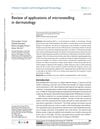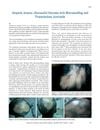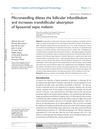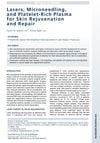Microneedling
aka - dermarolling
Microneedling, also known as collagen induction therapy or dermarolling, is a procedure that involves repeatedly puncturing the skin with tiny, sterile needles. Originally developed in the 1990s, it gained popularity in the early 2000s as a treatment for various skin conditions, such as scars, wrinkles, and acne. More recently, it has emerged as a promising treatment for hair loss, drawing attention for its potential to stimulate the scalp and enhance hair follicle function.
The use of microneedling for conditions like alopecia hinges on its ability to induce minor skin injuries that activate the body’s natural wound-healing processes. This healing response stimulates the production of collagen and elastin and releases growth factors that promote cell regeneration and increase blood circulation to the scalp. These physiological changes create a supportive environment for hair follicle rejuvenation, potentially reversing thinning and increasing hair density.
Microneedling and Hair Growth
Research into microneedling as a treatment for hair loss suggests it is particularly effective when combined with traditional therapies such as minoxidil or finasteride. A study published in the Indian Journal of Dermatology found that men with androgenetic alopecia who had not responded to conventional therapies experienced improved hair growth after integrating microneedling into their treatment regimen. Furthermore, evidence suggests that microneedling can independently stimulate hair regrowth by activating stem cells in the hair follicles.
The Microneedling Process: Mechanism of Action
Microneedling works by creating micro-injuries in the skin, which triggers the release of growth factors, platelets, proteins, and stem cells. This response fosters the breakdown of scar tissue and the formation of new blood vessels, while promoting the deposition of healthy collagen. In addition, the microscopic punctures enhance the absorption of topical treatments, which can work synergistically with the body’s natural processes to address hair loss.
Common Side Effects and Risks
Microneedling is a relatively safe procedure, but it is not without risks. Mild side effects include temporary redness (erythema), pinpoint bleeding, and flaking, which generally subside within one to two days. In rare cases, more severe complications can occur, such as tram-track scarring, needle breakage, or allergic reactions to the needles or topical agents. Proper precautions, including using sterile equipment and following established protocols, can significantly reduce these risks.
Device Options for Microneedling
Microneedling devices come in three main types: rollers, stamps, and pens.
Rollers are manual devices with multiple needles that roll over the skin. While they are affordable and can cover large areas, they pose risks of uneven pressure application, angular trauma, and increased pain.
Stamps are manual devices that are better suited for localized treatments. They avoid angular trauma but are less effective for larger areas and may still cause inconsistent depth penetration.
Pens, which are automated devices, are generally regarded as the best option. They deliver consistent needle depth, are less painful, and can cover both small and large areas efficiently. However, they are typically more expensive than rollers or stamps.
Preparing for Microneedling
Before undergoing microneedling, it is essential to conduct a patch test to check for allergies to needles (especially nickel) or topical agents. The skin should be thoroughly sanitized using agents such as alcohol or betadine, and makeup must be removed to avoid introducing contaminants. A clean and sterile environment is critical to minimizing the risk of infection.
Performing the Procedure
The depth of needle penetration during microneedling varies depending on the area of treatment. For instance, the forehead typically requires depths of 0.7 to 1.0 mm, while the scalp may need up to 1.5 mm. The goal is to achieve mild redness or pinpoint bleeding, which signals an adequate treatment response.
During the procedure, a star-shaped motion is often used to ensure even coverage. This involves passing the device vertically, horizontally, and diagonally across the treatment area. The number of passes depends on the desired density of micro-punctures, with most protocols recommending 200 to 250 punctures per square centimeter.
Post-treatment care includes gentle cleaning of the skin with sterile water or gauze and avoiding sun exposure for at least a week. Makeup application should be delayed for two days to prevent irritation or infection.
Combining Microneedling with Topical Treatments
Many users pair microneedling with topical treatments such as minoxidil or platelet-rich plasma (PRP) to enhance results. Studies indicate that microneedling improves the absorption and efficacy of these treatments. However, it is generally recommended to wait 12 to 24 hours after microneedling before applying topicals to minimize the risk of adverse reactions.
Treatment Frequency
The frequency of microneedling sessions depends on the needle depth used. Shallow treatments (<0.15 mm) can be performed every two to three days, while deeper treatments (1–1.5 mm) require longer recovery periods of one to four weeks. For scar treatment, deeper needling (up to 3 mm) may be performed every six to eight weeks.
Contraindications and Precautions
Microneedling is not suitable for everyone. Individuals with certain conditions, such as active skin infections, autoimmune diseases, or a predisposition to keloid scarring, should avoid the procedure. Additionally, caution is advised when combining microneedling with cardiac-affecting drugs like minoxidil, especially for those with pre-existing heart conditions.
Summary of Research
Numerous studies support the efficacy of microneedling for treating alopecia:
- A 2013 study by Dhurat et al. demonstrated that microneedling combined with minoxidil resulted in significantly better hair regrowth than minoxidil alone.
- Kim et al. (2016) found that microneedling promoted hair growth in mice, with optimal results at needle lengths of 0.25–0.5 mm.
- Jha et al. (2019) reported that combining microneedling with PRP and minoxidil produced superior results compared to minoxidil alone.
Frequently Asked Questions
Does microneedling alone promote hair growth?
Yes, though the results are more pronounced when combined with treatments like minoxidil or PRP.
Can microneedling cause scarring?
Not under normal circumstances. Proper technique and tools ensure minimal risk, but improper use can lead to scarring.
Is significant bleeding normal?
No. Only pinpoint bleeding is expected during a proper microneedling session.
Microneedling represents a minimally invasive and versatile option for those seeking to improve scalp health and promote hair growth. While it is not without risks, careful adherence to established protocols and proper device use can maximize its benefits while minimizing potential complications.
Research
20 / 1000+ results
research Review of Applications of Microneedling in Dermatology

research Combined Autologous Platelet-Rich Plasma with Microneedling Versus Microneedling with Distilled Water in the Treatment of Atrophic Acne Scars: A Concurrent Split-Face Study

research Microneedling: Current Status and Systematic Literature Review

research Response to Microneedling Treatment in Men with Androgenetic Alopecia Who Failed to Respond to Conventional Therapy

research Microneedling for the Treatment of Hair Loss

research Alopecia Areata: Successful Outcome with Microneedling and Triamcinolone Acetonide

research A Comparative Study of Microneedling with Platelet-Rich Plasma Plus Topical Minoxidil (5%) and Topical Minoxidil (5%) Alone in Androgenetic Alopecia

research Platelet-Rich Plasma with Microneedling in Androgenetic Alopecia Along with Dermoscopic Pre- and Post-Treatment Evaluation

research Microneedling Dilates the Follicular Infundibulum and Increases Transfollicular Absorption of Liposomal Sepia Melanin

research Preliminary Results of the Use of Scalp Microneedling in Different Types of Alopecia

research Platelet-Rich Plasma and Microneedling Improve Hair Growth in Patients with Androgenetic Alopecia When Used as an Adjuvant to Minoxidil
research A Randomized Controlled, Single-Observer Blinded Study to Determine the Efficacy of Topical Minoxidil Plus Microneedling Versus Topical Minoxidil Alone in the Treatment of Androgenetic Alopecia

research Is Skin Microneedling a Good Alternative Method for Various Skin Defects Removal

research Lasers, Microneedling, and Platelet-Rich Plasma for Skin Rejuvenation and Repair
research Safety Profile for Microneedling: A Systematic Review

research Combination of Photodynamic Therapy with 5-Aminolaevulinic Acid and Microneedling in the Treatment of Alopecia Areata Resistant to Conventional Therapies: Our Experience with 41 Patients

research Efficacy and Safety of Microneedling and Oral Tranexamic Acid in the Treatment of Facial Melasma in Women: An Open, Evaluator-Blinded, Randomized Clinical Trial

research Platelet-Rich Plasma Microneedling Versus 5% Topical Minoxidil in the Treatment of Patterned Hair Loss

research An Overview of the Biology of Platelet-Rich Plasma and Microneedling as Potential Treatments for Alopecia Areata
